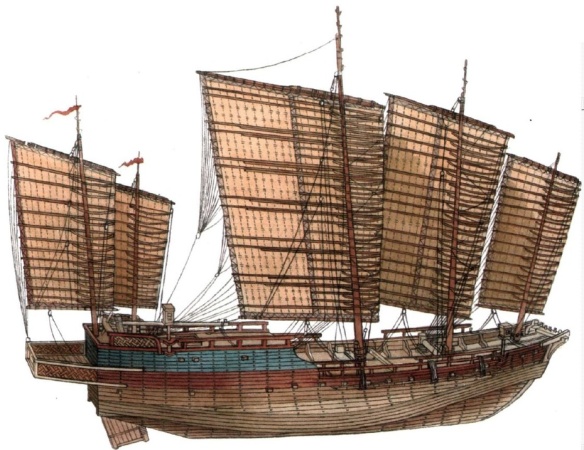
Mongol ships.
Japanese attack ships. Moko Shurai Ekotoba, 1291.
Qubilai’s expeditions against Japan, finally wrecked by the famous kamikaze (divine wind), became great burdens on Mongol-ruled China and Korea. By the 13th century the military government in Kamakura (1185–1333), dominated by the Hojo family, had removed the emperor in Kyoto from actual administration. Japan had no formal relations with the mainland, but Japanese Buddhist pilgrims, merchants, and pirates all regularly crossed the East China Sea.
QUBILAI KHAN (1260–94) first learned of Japan in 1265 from a Korean interpreter. From 1266 to 1272 Qubilai’s repeated dispatch of envoys was stymied first by Korean noncooperation and then by the Hojo family’s refusal to allow the Japanese emperor to receive them. In July 1271 the Korean interpreter Cho Kaesu¢ng first proposed invasion. In November 1274 a fleet under Prince Hindu and the Korean Hong Tagu (1244–91), with 1,000 transport ships, 300 ba’atur (hero) light warships, and 300 smaller craft and 15,000 fighting men, set out from Korea against Japan. The flotilla seized a beachhead at Hakata (modern Fukuoka), defeating the Japanese defenders. Soon, however, a storm threatened the fleet, forcing it to reembark with heavy losses. The Hojo now extensively walled the Hakata waterfront and slew Qubilai’s later envoys.
In 1280 Qubilai ordered the Song defector Fan Wenhu to lead what was said to be a 100,000-man fleet from Quanzhou (Amoy) against Japan. Korea was to ferry 40,000 North Chinese, under Aq-Taghai (1235–90) of the Suldus, on 900 ships and contribute 10,000 men. The northern fleet sailed on June 10, 1281, reaching Munakata. Fan Wenhu’s fleet landed at Imari somewhat later. On August 15 and 16 a typhoon destroyed much of both fleets. Aq-Taghai and Fan Wenhu embarked for the mainland with the seaworthy ships, leaving the remaining troops to be crushed by the Japanese, who butchered the captured Mongol, Korean, and Han (North Chinese) men and enslaved the “Tang” (South Chinese). From 1283 to 1286 Qubilai amassed ships, grain, and sailors for another expedition, even recruiting tattooed criminals and former salt smugglers as marines. Qubilai finally canceled the expedition so as to facilitate his invasion of VIETNAM.
Shinto priests believed the storm that destroyed the Mongol fleet to be a “divine wind” (kamikaze). The Moko shurai ekotoba (“The Mongol Invasion Painted Scroll,” c. 1293) is one of the masterpieces of Japanese painting and a valuable source on the invasion.
Further reading: Thomas Conlan, In Little Need of Divine Intervention: Takezaki Suenaga’s Scrolls of the Mongol Invasions of Japan (Ithaca, N.Y.: Cornell University Press, 2001).